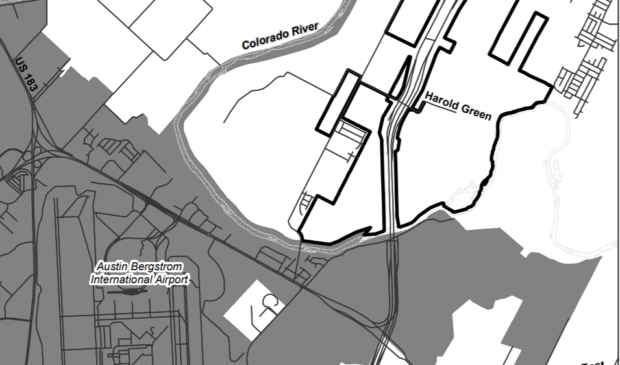East Austin 2K-acre PUD gets unanimous seal of approval from Environmental Commission
Monday, January 27, 2020 by
Jessi Devenyns The future of a decades-old sand and gravel mine just east of the Austin city limits on Harold Green Road is now clearer with the latest set of plans developers presented to the Environmental Commission on Jan. 15.
Known as the Austin Green PUD, the 2,122-acre property has been marching through city planning for nearly two years, and last week, the Environmental Commission unanimously recommended approval of the PUD.
“I can’t say enough good stuff about where this lands on parks and open space,” said Atha Phillips with the Watershed Protection Department. The proposed plans include 858 acres of allocated open space and parkland, three miles of which is public parkland along the Colorado River. The dedicated open space amounts to 40 percent of the property.
As a result of so much planned green space and consolidated development, Phillips said the impervious cover on the entire parcel will not exceed 65 percent. Code allows commercial developments to have 80 percent impervious cover.
“It’s not about development and ecology, but how those two can work together,” Steven Spears, a principal with the developer GroundWork Development, told the commission. Spears explained that restoring one-third of the mine-pitted landscape opens it up both for recreational visitors and residents from a multitude of economic strata.
In order to make the numbers work, Spears outlined a plan where there will be 10.5 units per acre of diverse housing options in the planned development including apartments, duplexes and single-family homes. In total, this will amount to 12,800 units of residential, 15 percent of which will be affordable at 60 percent of median family income for 40 years. Five percent of the units will be affordable at 80 percent of MFI for 99 years. The rest of the development will consist of 2.25 million square feet of mixed-use commercial space, including office, industrial and civic uses.
According to Spears, this density strategy allows for a one-to-one jobs-to-housing balance. He acknowledged that the goal may seem “utopian” but “that’s what we’re striving for.”
Commissioner Andrew Creel called the affordable housing allocation “above and beyond,” saying, “It is really going to be a big benefit to that town center.”
In order to achieve the construction of this housing and provide services to residents, the PUD is proposing to create a new municipal utility district encompassing the development. A MUD is a district outside city limits that is funded by bond dollars to pay for the infrastructure, including water, sewer, drainage, road facilities and park maintenance.
For the creation of Austin Green MUD, the proposed bond obligation is $995 million. Property taxes within the district will pay back that loan, which is projected to take 25 years. The anticipated build-out timeline for the entire project is 30 years.
City Council approved creation of the MUD at its Jan. 23 meeting.
The developers intend to approach the restoration of the site in phases. A large component will involve the conversion of mining sites into detention ponds that will be large enough to allow kayaking and fishing in addition to their work in flood mitigation. There will also be six miles of trails and nonmotorized boat access to the Colorado River.
Commissioner Pam Thompson encouraged further incorporating green building techniques into the construction as well as rainwater harvesting across the developed areas. As designed, the Austin Green PUD will need to achieve a two-star or greater rating under the Austin Energy Green Building program.
The presented plans came to the Environmental Commission with staff support and left with the unanimous recommendation from commissioners. Commissioner Ryan Nill was absent from the discussion.
This story has been corrected since publication to reflect the fact that the proposed PUD will have 12,800 units — not square feet — of residential development. Map courtesy of the city of Austin.
The Austin Monitor’s work is made possible by donations from the community. Though our reporting covers donors from time to time, we are careful to keep business and editorial efforts separate while maintaining transparency. A complete list of donors is available here, and our code of ethics is explained here.
You're a community leader
And we’re honored you look to us for serious, in-depth news. You know a strong community needs local and dedicated watchdog reporting. We’re here for you and that won’t change. Now will you take the powerful next step and support our nonprofit news organization?









